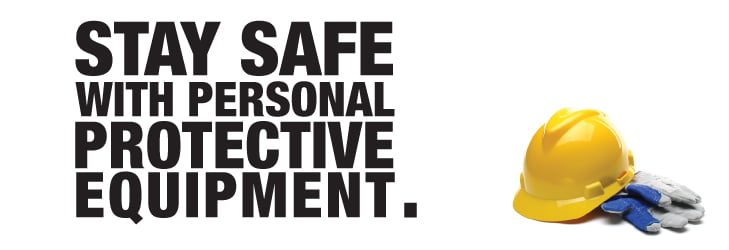Stay safe with Personal Protective Equipment
05/12/2014

Sometimes you are faced with real challenges on the job; risks to your health and safety that cannot be controlled in any way but by Personal Protective Equipment (PPE). While this type of work should be avoided if possible, we all know that sometimes work of this kind just has to be done. In cases like these it’s essential that PPE is used to prevent serious injury in the workplace.
What is PPE?
Personal Protective Equipment (PPE) is equipment that will protect a user against health and safety risks at work and includes items such as safety helmets, high visibility clothing, safety footwear and safety harnesses. Failure to be provided with such equipment can lead to injuries including amputations where safety gloves or boots aren’t worn, head or brain injuries caused by a lack of safety helmet, and life-threating injuries caused by a faulty harness.
It is an employer’s responsibility to provide PPE equipment in the workplace – as it aligns with their duty of care responsibilities. According to the Personal Protective Equipment at Work Regulations 1992:
- An employer needs to ensure that the PPE is properly assessed before used to ensure it’s suitable
- An employer has to provide their employees with instructions on how to use the PPE correctly
- An employer also has to ensure that employees follow the guidance and safety instructions they’ve been given
Must-have PPE when using ladders and access equipment
- Safety helmet – This protects impact on an employees head should they fall or be hit by flying or falling objects. There are a range of helmets, hard hats and bump caps available so it’s essential to choose the right one for your working conditions. Some helmets also incorporate specially-designed eye or hearing
- protection, which can also be useful in an industrial setting
Safety glasses – Glasses should be worn to protect eyes from materials and dust. It’s important that safety glasses and goggles aren’t left lying around or stored among tools where they can be damaged - High-visibility jacket – If an employee is working on a construction site, clothing such as a reflective safety vest should be worn to ensure clear visibility
- Gloves – To protect an employee against cuts, punctures, impact, chemicals and electric shock, the HSE recommend wearing appropriate gloves
- Safety boots – To protect employees from slipping, and to protect feet from falling objects, safety boots must be worn. Footwear can have a variety of sole patterns and materials to help prevent slips in different conditions. It’s essential that the right footwear is chosen.
- Safety harnesses – These need to be used to protect the body and prevent catastrophic incidents like falls. Harnesses to consider include the basic lightweight full body harness, fall arrest lanyard, retractable fall arrester, fall arrest blocks and flexible anchorage lines.
For more information on keeping safe at work and how to use PPE equipment, book onto one of our safety training courses. If you’re unsure which one is most suitable to your needs, give us a call on 01282 615 517 and we’ll let know which course best meets your requirements.